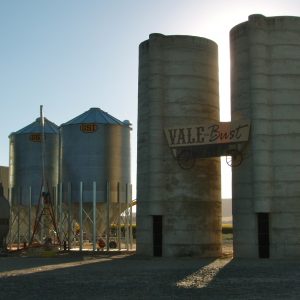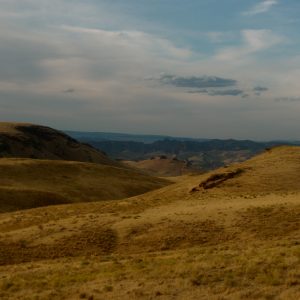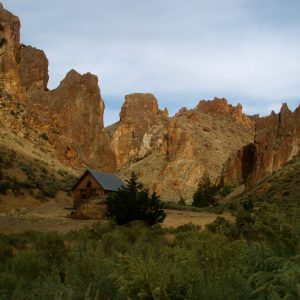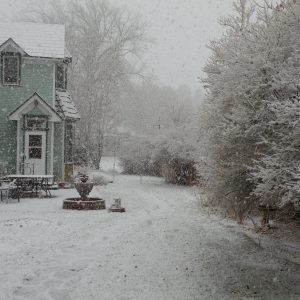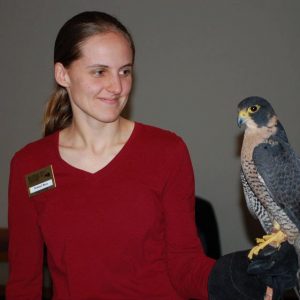We continue to work away in the Lower Sonoran Desert. Opportunities have been amazing as we continue to work on a number of projects. It is amazing to be able to expand my knowledge of the area as well as learn new skills. In just the short time since my last post I have had the ability to assist in installing a solar well for the endangered Sonoran pronghorn this will allow the agency to save money because of the expensive maintenance of the older wind mills. I also was able to assist in the relocation of some Sonoran pronghorn to the Kofa National Wildlife Refuge which was an amazing experience to just be a part of . With only a few hundred of these pronghorn left it was a once in a lifetime opportunity to be able to be so close to them. I hope to have more exciting news next month!
Winter, and a new beginning
I moved to Boise, Idaho two weeks ago. Coming from Miami, the scenery seems barren due to the lack of green. It is also significantly colder, about 30 degrees compared to 70 degrees. Once I bought a winter jacket (there were none in Miami stores), I felt comfortable. Now I’m used to biking in the cold weather, and commuting to work in below freezing weather. I can see why layers are so important.
During the winter I will mostly be working on databasing projects. There is a large collection of lichens, at the BLM herbarium that needs to be reorganized and updated. It’s amazing how many nuances there are to maintaining a herbarium. Some of the details that need to be considered are nomenclature changes, GPS, and making sure all the details on the collection label match the database record. It is time consuming but rewarding to know that I am putting together a collection that future researchers can utilize.
At the moment, I am working on a Florida lichen database, checking all 1,000 records and tying up all the loose ends. My boss collected lichens in Florida for many years, and would like to donate the lichens to Florida institutions. Many universities in Florida do not have large collections of Florida lichens, and this is a way to disseminate knowledge and put the lichens in a place where they will be useful and accessible. For my undergraduate studies, I studied Florida lichens, so the opportunity to continue working with them is exciting. There is so much to study, and the information from this database will be important for ecological research.
I hope to go out in the field next week. There might be sagebrush seeds to collect. If there is precipitation or snow, it might be possible to lay some seeds on a restoration site. I’m very curious to see what this desert looks like. From afar it looks lifeless, but I’m sure many plants are growing, camouflaged into the scenery.
Seed Banking
When I tell people I collect seeds for seed banking, the first question I’m asked is if the collections are stored in the Svalbard Global Seed Vault, which is located on the Norwegian island of Spitsbergen. While it’s awesome that so many people know about that bank, it is used primarily for agricultural species. Native plant species, especially those that are not threatened or endangered, receive much less attention. There are very few native seed banks around the world, and San Diego County happens to have one.
The seed bank here at the Safari Park houses more than five hundred different
plant populations. It is a straw bale, solar-powered structure that has all sorts of interesting contraptions used for seed processing. The seed bank is located at the back of the park and is the first permitted straw bale building in San Diego County. Cleaning and storing seeds is time consuming and often tricky, but it can also be very rewarding. Our goal is to collect multiple populations of the same species because each population may have adaptations unique to its
location. San Diego County is home to over 1,500 different plant species, so that adds up to a lot of seed collections!
When we first find a population that we want to collect we take clippings of the plant and press them to preserve the specimens (herbarium vouchers). It is best to take a sample that has both flowers and leaves so that the species can be verified by a specialist. Our herbarium vouchers are sent to the San Diego Natural History Museum for verification. Data on the location, soil color, slope, habitat, and associated species are also collected. After theses initial steps are taken we monitor the population until enough of the seeds ripen for a collection. We often have to compete with herbivores and rough weather to collect the seed before it is lost.
Once the collection is made, it is taken back to the seed bank and processed. The steps involved in processing the seed lots are generally dependent on each particular species. The seed and plant material is often rubbed over screens of various sizes until the seed is separated from its various shells, pods, leaves, pappi, and stems. Once separated, it is run through air separators so that lighter material is blown off and/or the seeds are lifted away from the heavier debris.
Even after all of these techniques are used, we are often left with seed that is still mixed with extra plant material. When this happens, our only option left is to clean the seed lot by hand. With larger seeds this can be fairly easy, but with the small seeds it often involves a microscope, tweezers, and a lot of patience.
Clean seed lots are placed in the drying room in order to lower their moisture level. Once the seeds reach a moisture content between 5 and 9 percent, they can be placed in long-term storage. Five hundred of the seeds are counted out into groups of one hundred and then weighed. The entire seed lot is then weighed and we estimate the total number of seeds. At least ten thousand seeds are placed in storage at a time. If there are extra they are set aside for future
restoration and research. The seed is sealed in double-layered foil bags and frozen. It has been proven through germination testing that frozen seeds remain viable for decades.
Reflecting…
It’s been over a month since I left the Vale BLM office, so now; I find its time to reflect.
The skills and knowledge I gained from the work I did and the individuals I met have become part of me. They have made me a more confidant and experienced person. However, the field techniques, the plant names, the navigational skills are not what I think of now when I look back. When I think Vale… the desert is what I will forever remember.
I recently moved to the forested mountains of Colorado. Though they are beautiful, I miss the vastness of the high Oregon desert. I miss being able to see for hundreds of miles every day. I miss the sparse but strong plants I spent the summer looking for. The rolling hills, short fragrant sagebrush, and dancing shadows of the desert awakened in me an incredible sense of oneness with the land I worked with everyday throughout the summer. The vast Oregon land gave me a sense of place and belonging.
Its funny that when I started my internship I thought “oh wow, this is my first ‘real job’, my entrance into the ‘real world’”, what I entered into was a world where I experienced what I hope the rest of my life will be based on; studying and experiencing natural life, and working to protect it. The desert has made me question and reflect on my existence, my purpose, and my place. I hope to return to the desert shortly to find more answers… and discover more questions.
Since I couldn’t say it as well myself, a quote by Rumi.
Let the beauty of what you love be what you do. There are a thousand ways to kneel and kiss the earth. (Rumi)
- Vale or BUST!
- The desert
- Leslie Gulch – A place of historic spiritual awakening for Native Americans in the area, as well as personal spiritual awakening.
Happy Holidays!
This is my final month in New Mexico. Next week my brother flies out to endure the 24 hour drive home with me. He’ll be the first and last visitor at my mountain home and there is so much of the Land of Enchantment that I want to show him before we head off. Everybody who I’ve interacted with during the past 6 months has made a lasting impact on me: My mentor is one of the most patient and educated bosses that I’ve ever had, the group of friends I have developed at the office are amazing, and leaving my amazing “mountain family” (the two host families and some of the volunteers at the recreation center) will be hard to do.
December made sure its presence was noticed. A week ago, my part of New Mexico experienced more snow and chilly temperatures then my family in the Midwest experienced. After receiving a brief flurry, our office (as well as Roswell and Carlsbad) was released an hour early and granted a snow day. Although I was anticipating a snow-free winter, the powdered mountaintops offered a much more enjoyable experience as opposed to the ugly black slush and knee-high snow that the Chicago area is accustomed to. Plus everything melted by the weekend and temperatures were back to the mid-50’s.
Now to reminisce about the past half year…
My first week as a CLM intern began in June at the workshop held in Chicago. I hadn’t even been to Las Cruces and I had absolutely no clue what to expect out of this internship. I met my co-intern, whom I would be living and working with. I was also able to get introduced with the Seeds of Success program and the process involved in seed collection. The following week I made my first ever solo trip out west. At the end of July we made our first full-fledged, team SOS collection of Helenium microcephalum var. microcephalum in an overgrazed, cow-dung infested field. By the end of August and September we had completed eleven collections which we considered a success. The harsh winter freeze from the previous year mixed with the hot, dry summers resulted in few native plants going to seed. We spent weeks working on a population density survey for Escobaria duncanii which was undeniably my favorite project. Our team drove all over southern New Mexico looking for plants to collect and learning all about the different habitats. Our last project as a full team was collection of leaf samples from Lepidospartum burgessii in the salt flats near Guadalupe Mountain. In November, our team was down to two members: my mentor and I spent three days in Roswell retrieving updated plant statuses for the potted Culp Sand Bluestem project that began three years ago (The bluestem is a key element in the habitat for both the Lesser Prairie Chicken and the sand dune lizard). This month I helped my mentor set up a new survey area in the Franklin Mountains to observe the density of a population of Escobaria sneedii. It was a great project that allowed me to stay busy on office days but still got me out in the field quite often.
I’ve learned just as much in my free time as I have during my work days. Hiked along the Gila River and discovered that substantial sandals are great investments when the trail you follow crosses the water more than ten times. Watched my roommate discover the best way to collect, de-spine, and separate seeds from prickly pears to make jelly. Found out that it’s best to call ahead to forest campgrounds in the middle of hot, dry summers to see if they’re open or not before driving two hours to the site to find out that it’s closed due to extreme fire hazards. Discovered the best way to catch and remove tarantulas, scorpions and lizards from the bunkhouse and got stung by a scorpion (just last week, look out!). I learned that it is best to bring a flashlight when going to a nighttime tour of zoos. I finish a half marathon and an obstacle 5K race. I experienced the fantastic culture that surrounds the southwest and walked with the community in the Dia de los Muertos procession. And most importantly, I perfected my own version of green chili stew.

I found a cow-bone-cholla-shrine while hiking a trail around the Organs, decided it was a good point to turn back.
It’s amazing how much of what I have learned over a year and a half ago during college is actually being put to use in multiple aspects of this internship and I’m so inexplicably thankful to the cast at the Chicago Botanic Garden and my mentor for the opportunity to experience and explore New Mexico for the past 6 months. The countdown is on and I have less than 10 days before I leave my mountain home and one thing for sure is that it won’t be too long before I return! ¡Adios Nuevo Mexico!
A chance to travel, presenting my project, and tidying up
It’s been a while since I last wrote, so there is a fair amount of catch up to do. Going back to early November, I had a chance to travel to Tallahassee, FL to take part in the Natural Areas Association annual meeting. This was my first professional conference and it fit very well with my project. I heard many lectures on policies protecting natural areas (ranging from domestic parks, wildlife refuges, to the amazon), LOTS of information on invasive species, and several talks of other interests to me. Along with these lectures, I created a poster to display during the week regarding my project on Great Lakes invasive species. There were plenty of folks to talk with on the myriad issues that inevitably evolve as do the lists of invasives. One of the days we left the conference area and went to St. Mark’s wildlife refuge south of Tallahassee. This was unquestionably my favorite experience of the week. This refuge is extensive, covering habitats supporting red cockaded woodpeckers and gopher tortoises, long leaf pines, and shorebird (and alligator!) communities. The amount of new habitat I had a chance to explore in only a few hours was truly awesome. The biologists who manage the refuge provided a lot of insight into another realm of land management, foreign to me from my desk job with the NPS. This week was a great chance to get out and remember the wonderful diversity of positions available for me to pursue down the road.
After getting back to Fort Collins, it was back to work on the final bits of my project. I finished the design of the website housing the database, edited the species lists one more time, and began working on my webinar presentation for December. Work went well on this, and after a few more weeks, I presented the webinar. I will be spending my last week and a half cleaning up errors corresponding with comments we receive(d) on the database, writing an article for InsideNPS, and reporting on this project for my division’s annual report.
Another great travel experience I recently had was over Thanksgiving weekend when I traveled to visit my roommates family on the western slope of Colorado. The drive through the Rockies was as spectacular as I could have hoped, and seeing the San Juan Mountains on the other side of the state was a treat. While both the Front Range and western slope are significantly drier than I am used to in New England, it was great to see some trees on the drive over the mountain passes along with the pinyon-juniper “forests” of western Colorado. These trees were short and the ground was dry, lacking much of an understory other than sage brush; I suppose it’s like that from west of the Rockies to the Sierras, though. It certainly had its own beauty, though with open viewscapes and the jagged mountains surrounding the otherwise farmland. Upon returning to the Front Range, I stopped in the Black Canyon of the Gunnison NP for a bit. It was extremely impressive, and all the more enjoyable because there were no other visitors in sight. I’ll mark down Sundays in winter as the prime time for visiting parks as they should be seen– in solitude.
Only another week left, this has been a very rewarding and fast way to spend my first six months post graduation.
California Native Plant Society Cracks the Whip
There are an extraordinary number of projects taking place outside of the field season. With the California Native Plant Society (CNPS) Conference being held in San Diego this year, the San Bernardino National Forest is taking the lead on producing a display board to represent the Region 5 (California) Celebrating Wildflowers program. Celebrating Wildflowers is an outreach and education program created to increase the public’s understanding and appreciation of wildflowers. The program has funded me to work on events and publications this year. In July, I worked with a CNPS coordinator to plan and carry out a rare plant treasure hunt. We gathered 13 volunteers to revisit historically low occurrences of rare, threatened, and endangered species at a wet meadow on the forest. A botanist on the district I work with is a wonderful artist. Together we have produced a “Passport to the Wildflowers” to be handed out at the conference; this booklet is a guide to the botanical interest areas of the five southern California National Forests, complete with illustrations of the plant species. I am also working furiously to complete a report on a study I performed back in May. My mentor allowed me to design and carry out a study to determine the sex ratios of our endangered dioecious bluegrass, Poa atropurpurea. With field surveys taking up all of the summer and early fall months, the data was pushed aside for some time. Fortunately we have some positive findings which I will be presenting at the conference in just over a month! Extremely exciting but severely nerve wracking!
With all this work, I’ve been putting the ol’ social life on the back burner. This weekend is shaping up to be a winner though. On Friday I will be attending the Big Bear black tie event of the year, a 10 year anniversary party for the Big Bear Hot Shots—our wildland firefighter hand crew. Saturday I’ll be getting my first day of snowboarding in of the season and Sunday I’ll be heading to Joshua Tree National Park for rock climbing adventures!
Maps, Letters, and Herbicides
Well, I am still here. It’s been snowing from time to time, and field work for me is scarce. Mostly I spend my days on GIS mapping projects and summarizing sage grouse count data, but occasionally I get to help out with a field project controlling invasive Russian olive and salt cedar with herbicides. There’s just nothing like good old fashioned manual labor in zero degree temperatures! Then again, although it’s hard work carrying around a backpack sprayer that’s almost half my body weight and made to be carried by broader shoulders over uneven terrain in the winter, after about 20 minutes of walking around that way we’re all toasty warm. Sore shoulders aside, it’s good to earn your supper once in a while.
Another work activity has been sending out letters to past volunteers for the Mid-Winter Eagle Survey to see who is game for participating in the survey next month. Responses keep rolling in, and soon it will be time to send out route maps and information and contact the people who haven’t responded yet. The survey will be on the last day of the first part of my internship, and I can’t believe it’s coming up so fast.
Volunteer activities with the Greater Yellowstone Raptor Experience program and the local animal shelter continue, which make me all the more excited to come back next year after my 2 month break in January. I anxiously await the arrival in the mail of my very own raptor glove for working with the birds at the Buffalo Bill Historical Center here in town. That has been one of the coolest things I’ve ever done, and I have the CLM program to thank for placing me here for this internship where I get to do all these cool things! (at work and beyond) It’s been a completely satisfying, valuable, and irreplaceable experience.
Winter in the Desert
Now that most of the seed collecting is coming to an end and most of the plants around here have gone to “bed” for the winter, I have been inside for most of the time. There are still a couple of seed collections that we would like to complete, but now it is a race to see who will get to them first – us or mother nature. We will see who comes out ahead. We even got snow here in Safford, AZ. I was surprised by that, granted it didn’t last very long. But moisture is moisture, and we could use it. And maybe we will get enough winter rains to get some spring flowers and other annual plants up this coming spring. We can only hope. But for now things are calming down, but there is still work to be done.
Dropping Like Flies
The intern team is shrinking rapidly. Our 9 person crew has now dropped to 3. Though I still have two months left, I’m constantly aware that the end is rapidly approaching and that I need to figure out what’s happening next. Whatever it is, I’m sure it will require a move. And while there’s always some excitement about getting to see a new place, I really hate moving and would like to find a good place to settle down for awhile. In the meantime, the ski season at Tahoe has begun, and I can now get to work on becoming a less awful skier.
Here is a random batch of semi-recent internship-related photos:


